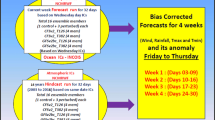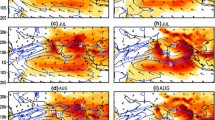Abstract
The Indian summer monsoon of 2013 covered the entire country by 16 June, one month earlier than its normal date. Around that period, heavy rainfall was experienced in the north Indian state of Uttarakhand, which is situated on the southern slope of Himalayan Ranges. The heavy rainfall and associated landslides caused serious damages and claimed many lives. This study investigates the scientific rationale behind the incidence of the extreme rainfall event in the backdrop of large scale monsoon environment. It is found that a monsoonal low pressure system that provided increased low level convergence and abundant moisture, and a midlatitude westerly trough that generated strong upper level divergence, interacted with each other and helped monsoon to cover the entire country and facilitated the occurrence of the heavy rainfall event in the orographic region. The study also examines the skill of an ensemble prediction system (EPS) in predicting the Uttarakhand event on extended range time scale. The EPS is implemented on both high (T382) and low (T126) resolution versions of the coupled general circulation model CFSv2. Although the models predicted the event 10–12 days in advance, they failed to predict the midlatitude influence on the event. Possible reasons for the same are also discussed. In both resolutions of the model, the event was triggered by the generation and northwestward movement of a low pressure system developed over the Bay of Bengal. The study advocates the usefulness of high resolution models in predicting extreme events.












Similar content being viewed by others
References
Abhilash S, Joseph S, Chattopadhyay R, Pattnaik S, Krishna PM, De S, Sahai AK, Goswami BN (2012) Performance of an Ensemble Prediction System based on CFSV2 for the Extended Range Prediction of Active-Break Spells of Indian Summer Monsoon Rainfall during 2011. IITM Res Rep RR-128
Abhilash S, Sahai AK, Borah N, Chattopadhyay R, Joseph S, Sharmila S, De S, Goswami BN, Arun Kumar (2014a) Prediction and Monitoring of Monsoon Intraseasonal Oscillations over Indian monsoon region in an Ensemble Prediction System using CFSv2. Clim Dyn, online, January 2014, doi:10.1007/s00382-013-2045-9
Abhilash S, Sahai AK, Pattnaik S, Goswami BN, Kumar A (2014b) Extended range prediction of active-break spells of Indian summer monsoon rainfall using an ensembleprediction system in NCEP climate forecast system. Int J Climatol doi:10.1002/joc.3668
Borah N, Abhilash S, Joseph S, Chattopadhyay R, Sharmila S, Sahai AK (2013) Development of extended range prediction system using CFSv2 and its verification. IITM Res Rep RR-130
Dee DP et al (2011) The ERA-Interim reanalysis: configuration and performance of the data assimilation system. Q J R Meteorol Soc 137:553–597. doi:10.1002/qj.828
Dobhal DP, Gupta AK, Mehta M, Khandelwal DD (2013) Kedarnath disaster: facts and plausible causes. Curr Sci 105:171–174
Dube A, Ashrit R, Ashish A, Sharma K, Iyengar GR, Rajagopal EN, Basu S (2014) Forecasting the heavy rainfall during Himalayan flooding in June 2013. Weather and Climate Extremes In press. doi:10.1016/j.wace.2014.03.004
Dubey CS, Shukla DP, Ningreichon Usham AL (2013) Orographic control of the Kedarnath disaster. Curr Sci 105:1474–1476
Ek M, Mitchell K, Lin Y, Rogers E, Grunmann P, Koren V, Gayno G, Tarpley J (2003) Implementation of Noah land surface model advances in the National centers for environmental prediction operational mesoscale Eta model. J Geophys Res 108(D22):8851
Francis JA, Vavrus SJ (2012) Evidence linking Arctic amplification to extreme weather in mid-latituides. Geophys Res Lett 39:L06801. doi:10.1029/2012GL051000
Gong D-Y, Ho C-H (2003) Arctic Oscillation signals in the East Asian summer monsoon. J Geophys Res 108. doi:10.1029/2002JD002193
Griffies SM, Harrison MJ, Pacanowski RC, Rosati A (2004) A Technical Guide to MOM4. GFDL Ocean Group Technical Report No 5 Princeton NJ NOAA/Geophysical Fluid Dynamics Laboratory 342 pp
Hong C-C, Hsu H-H, Lin N-H, Chiu H (2011) Roles of European Blocking and the tropical–extratropical interaction in the 2010 Pakistan flooding. Geophys Res Lett 38:L13806. doi:10.1029/2011GL047583
Houze RA, Rassmussen KL, Medina S, Brodzik SR, Romatschke U (2011) Anomalous atmospheric events leading to the summer 2010 floods in Pakistan. Bull Am Meteorol Soc. doi:10.1175/2010BAMS3173.1
IMD (2013) Monsoon 2013: a report. IMD Met Monograph No.: ESSO/IMD/SYNOPTIC MET/01-2014/15. India Met Department Eds Pai DS and Bhan SC. http://www.imdpune.gov.in/
Kalnay E et al. (1996) The NCEP/NCAR 40-year reanalysis project. Bull Am Meteorol Soc 77. doi:10.1175/1520-0477
Lau WKM, Kim K-M (2012) The 2010 Pakistan flood and Russian heat wave: teleconnection of hydrometeorological extremes. J Hydrometeorol 13:392–403. doi:10.1175/JHM-D-11-016.1
Li W, Fu R (2006) Influence of cold air intrusions on the wet season onset over Amazonia. J Clim 19:257–275
Lorenz EN (1950) Seasonal and irregular variations of the Northern Hemisphere sea level pressure profile. J Meteorol 8:52–59
Martin JE (2006) Mid-latitude atmospheric dynamics: a first course. Published by Wiley Blackwell ISBN: 978-0-470-86465-4 June 2006
Martius O, Sodemann H, Joos H, Pfahl S, Winschall A, Croci-Maspoli M, Graf M, Madonna E, Mueller B, Schemm S, Sedl´aˇcek J, Sprenger M, Wernli H (2013) The role of upper-level dynamics and surface processes for the Pakistan flood of July 2010. Q J R Meteorol Soc 139:1780–1797. doi:10.1002/qj.2082
Misra A, Srinivasan J (2013) Did a cloud burst occur in Kedarnath during 16 and 17 June 2013? Curr Sci 105:1351–1352
Mitra AK, Bohra AK, Rajeevan M, Krishnamurti TN (2009) Daily Indian precipitation analyses formed from a merged of rain-gauge with TRMM TMPA satellite derived rainfall estimates. J Meteorol Soc Jpn 87A:265–279
Saha S et al (2014) The NCEP climate forecast system version 2. J Clim 27:2185–2208. doi:10.1175/JCLI-D-12-00823.1
Sahai AK, Sharmila S, Abhilash S, Chattopadhyay R, Borah N, Krishna RPM, Joseph S, Roxy M, De S, Pattnaik S, Pillai PA (2013) Simulation and extended range prediction of monsoon intraseasonal oscillations in NCEP CFS/GFS version 2 framework. Curr Sci 104 No.10 25 May 2013
Screen JA, Simmonds I (2010) The central role of diminishing sea ice in recent Arctic temperature amplification. 464. doi:10.1038/nature09051
Srinivasan J (2013) Predicting and managing extreme rainfall. Curr Sci 105:7–8
Thompson DWJ, Wallace JM (1998) The Arctic oscillation signature in the wintertime geopotential height and temperature fields. Geophys Res Lett 25:1297–1300
Thompson DWJ, Wallace JM (2000) Annular modes in the extratropical circulation Part-I month-to-month variability. J Clim 13:1000–1016
Wang S-Y, Davies RE, Huang W-R, Gillies RR (2011) Pakistan’s two-stage monsoon and links with the recent climate change. J Geophys Res 116:D16114. doi:10.1029/2011JD015760
Webster PJ, Toma VE, Kim H-M (2011) Were the 2010 Pakistan floods predictable? Geophys Res Lett 38:L04806. doi:10.1029/2010GL046346
Wu X, Moorthi KS, Okomoto K, Pan HL (2005) Sea ice impacts on GFS forecasts at high latitudes. Preprints Eighth Conf. on Polar Meteorology and Oceanography San Diego CA Am Meteorol Soc 7.4 [Available online at http://ams.confex.com/ams/pdfpapers/84292.pdf]
Xavier PK, Marzin C, Goswami BN (2007) An objective definition of the Indian summer monsoon season and a new perspective on ENSO-monsoon relationship. Q J Meteorol Soc 133:749–764
Acknowledgments
IITM is fully supported by Ministry of Earth Sciences, Govt. of India. We are thankful to Prof. B. N. Goswami, Director, IITM for his encouragement and support. SS is grateful to CSIR for financial assistance. The authors thank Dr. D. R. Sikka and Dr. J. R. Kulkarni for useful discussions and valuable comments. Authors are grateful to the two anonymous reviewers for their valuable, insightful and constructive comments. The model runs are carried out on Prithvi IBM High Performance Computing System installed at IITM, Pune.
Author information
Authors and Affiliations
Corresponding author
Electronic supplementary material
Below is the link to the electronic supplementary material.
Rights and permissions
About this article
Cite this article
Joseph, S., Sahai, A.K., Sharmila, S. et al. North Indian heavy rainfall event during June 2013: diagnostics and extended range prediction. Clim Dyn 44, 2049–2065 (2015). https://doi.org/10.1007/s00382-014-2291-5
Received:
Accepted:
Published:
Issue Date:
DOI: https://doi.org/10.1007/s00382-014-2291-5




